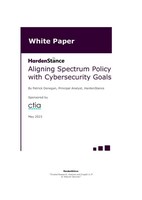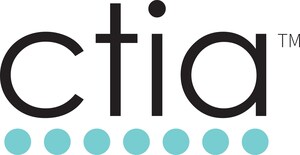WASHINGTON, May 24, 2023 /PRNewswire/ -- Exclusive-use, licensed spectrum is the best allocation model for building resilient, highly-secure networks to meet today's cybersecurity challenges, according to a new report from HardenStance, commissioned by CTIA. The report finds that licensed spectrum incentivizes wireless operators to invest in security, provides the best platform for the development and deployment of cybersecurity best practices and technologies, and enables operators to deliver consistent, reliable connections, with limited risk of interference.
"At a time when we are facing increased cybersecurity threats, it's critical that policymakers swiftly restore the FCC's auction authority and allocate more spectrum for licensed, commercial use," said Meredith Attwell Baker, CTIA President and CEO. "Licensed spectrum is a key input into building secure communications networks that support a safe and reliable internet experience."
The report recommends that spectrum policy should attach more weight to a user's incentive and ability to defend America's wireless networks against high impact cyber-attacks – whether they be by nation state adversaries or other cyber threat actors. For this reason, and thanks to the incentives and capabilities enabled by licensed spectrum, policymakers should seek to allocate more spectrum under exclusive-use, licensed frameworks.
"Aligning spectrum policy with the cybersecurity requirements of the next 10 years requires that the FCC should prioritize releasing mid-band spectrum as licensed spectrum," said Patrick Donegan, Principal Analyst, HardenStance.
HardenStance cites several reasons why users of licensed spectrum are able to build and manage the most secure wireless networks thanks to licensed spectrum, including:
- Commercial Incentive. Licensed holders invest billions to acquire spectrum licenses, including $233 billion in U.S. spectrum auctions, which further incentivizes them to take steps to protect their asset so that they can generate an appropriate return. For instance, according to HardenStance, wireless providers bear a lot of the cost of protecting networks against DDoS attacks in order to "maintain service availability for all of their customers."
- Security Architecture. Licensed spectrum users deploy advanced security architectures, developed by expert, international standards-setting bodies. Thanks to this approach, wireless providers are deploying 5G networks with advanced security features such as mutual authentication and automatic encryption. Wireless providers' oversight of their networks and the licensed spectrum that underpins them means that all the devices that users connect to wireless networks can be monitored, managed, and benefit from 5G's enhanced security features.
- Public-Private Collaboration. Licensed spectrum users collaborate closely with the U.S. government's cybersecurity ecosystem, which helps ensure that information on threats and safeguards are shared among all relevant parties. One example is the FCC's Communications, Security, Reliability and Interoperability Council (CSRIC), where operators collaborate to augment existing cybersecurity standards.
HardenStance finds that licensed spectrum drives high standards, accountability, and a high degree of commonality and predictability in the way wireless carriers protect and curate spectrum assets against cyber threats.
Unlicensed spectrum isn't managed, monitored, or secured in these same ways. As HardenStance says, "Neither the FCC nor any other government agency has anything like the same expectations of unlicensed spectrum holders with respect to collaboration and accountability in areas like cyber incident reporting in the broader national interest."
SOURCE CTIA

WANT YOUR COMPANY'S NEWS FEATURED ON PRNEWSWIRE.COM?
Newsrooms &
Influencers
Digital Media
Outlets
Journalists
Opted In






Share this article